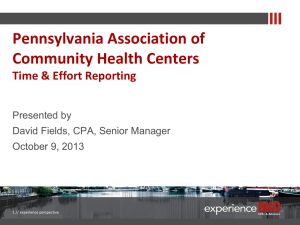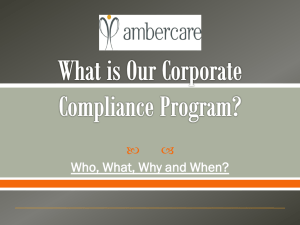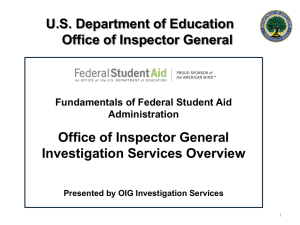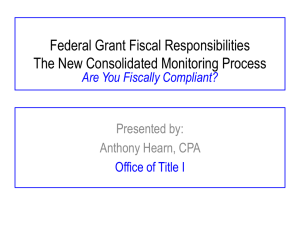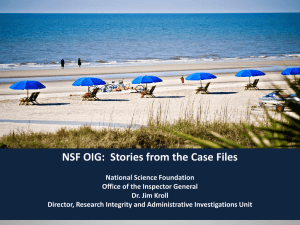The OIG & You: Health Care Compliance Programs (and ACOs) in
advertisement
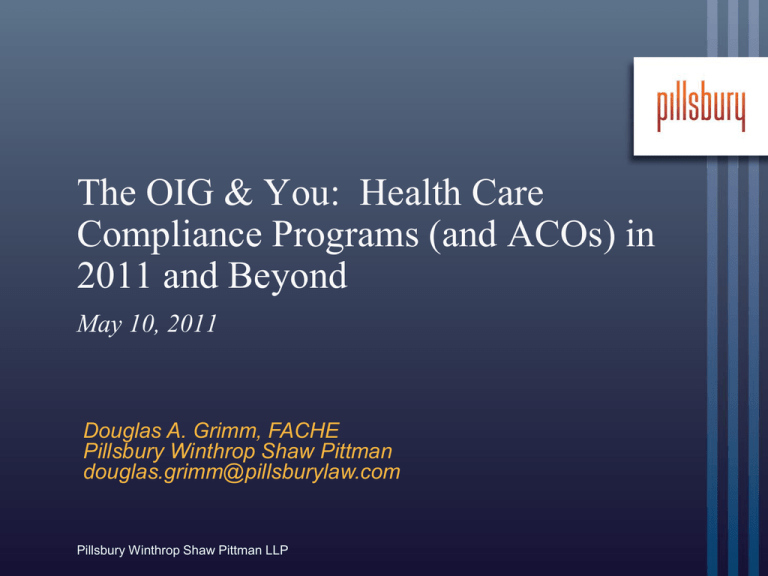
The OIG & You: Health Care Compliance Programs (and ACOs) in 2011 and Beyond May 10, 2011 Douglas A. Grimm, FACHE Pillsbury Winthrop Shaw Pittman douglas.grimm@pillsburylaw.com Pillsbury Winthrop Shaw Pittman LLP Pillsbury’s Health Care Capabilities Pillsbury’s Health Care team serves the legal needs of health care providers, physician groups, insurers, medical device manufacturers, group purchasing organizations and pharmaceutical companies. Our Health Care Industry Team members have extensive experience on legal issues specific to the industry, including: State and federal certification and licensure Medicare and Medicaid rules and regulations Patient privacy laws Reimbursement and other regulatory regimes Pillsbury's Health Care practice is nationally ranked by 2010 Chambers USA, a leading independent guide that interviews clients to compile its rankings. 2 | The OIG and You Tonight’s Agenda Part I : The Costs of Health Care Fraud and Abuse Part II : OIG’s 2011 Work Plan Part III : Deviations from the Normal (or How to Handle a Problem) Part IV : ACOs - Legal Structure, Governance & Compliance 3 | The OIG and You Part I: The Costs of Health Care Fraud and Abuse 4 | The OIG and You INTERNATIONAL COMPARISON OF HEALTH SPENDING 1980–2007 Average spending on health per capita ($US PPP) Total expenditures on health as percent of GDP 16% $7,290 8% $2,454 Note: $US PPP = purchasing power parity. Source: Organization for Economic Cooperation and Development, OECD Health Data, 2009 (Paris: OECD, Nov. 2009). 5 | The OIG and You 5 Fraud, Waste, and Abuse Costs Cost in Billions 1. Unwarranted Use $250-325 2. Fraud and Abuse $125-175 3. Administrative Inefficiencies $100-150 4. Provider Inefficiency and Errors $75-100 5. Lack of Care Coordination $25-50 6. Preventable Conditions $25-50 $600-850 Source: Thomson Reuters, 2011 6 | The OIG and You 6 7 | The OIG and You 7 8 | The OIG and You 8 Recent News: January 24, 2011 “U.S. Department of Health and Human Services Secretary Kathleen Sebelius and U.S. Associate Attorney General Thomas J. Perrelli today announced a new report showing that the government’s health care fraud prevention and enforcement efforts recovered more than $4 billion in taxpayer dollars in Fiscal Year 2010. This is the highest annual amount ever recovered from people who attempted to defraud seniors and taxpayers.”* In 2009, recovered $2.5 billion** *Sources: HHS press release Jan. 24, 2011 9 | The OIG and You 9 Part II: OIG’s 2011 Work Plan 10 | The OIG and You OIG’s Mission and Activities Mission: Protect program integrity and the well being of program beneficiaries by detecting and preventing waste, fraud, and abuse. Identify opportunities to improve program economy, efficiency, and effectiveness. Hold accountable those who do not meet program requirements or who violate Federal laws. Activities: Conduct audits, evaluations, and investigations. Provide guidance to industry. When appropriate, impose civil monetary penalties, assessments, and administrative sanctions. 11 | The OIG and You 11 Annual Work Plan Describes the activities and audits on which the OIG will focus for the protection of federal health program integrity. Furthers OIG’s goals to detect and mitigate fraud, waste, and abuse. Hold accountable those who do not meet program requirements. 2011 Work Plan was released October 1, 2010. Several new priorities. Largely builds on objectives in 2010 Work Plan. 2011 Work Plan omits EMTALA and coding and documentation under the MS-DRG system. 12 | The OIG and You 12 2011 Work Plan: New Priorities General areas of focus – less specific than in past years. New topics address quality, billing concerns. Any time OIG adds new issues to the work plan, providers who provide these services and other Medicare stakeholders should be knowledgeable of these changes. 13 | The OIG and You 13 2011 Work Plan: New Priorities (1) Replacement Devices Hospital receives full or partial credit from a device manufacturer – hospital must use modifiers on the inpatient and outpatient claims. Medicare not responsible for the full cost of a replaced medical device when hospital receives a credit from manufacturer of 50 percent or more for a replacement device. (2) Radiation Therapy Quality and Safety Review OIG to review safety and quality of intensity-modulated radiation therapy and image-guided radiation therapy. (3) Brachytherapy Reimbursement (4) Payments for Non-Physician Outpatient Services Under the Inpatient Prospective Payment System (“IPPS”) OIG to review appropriateness of the payments for non-physician outpatient services shortly before or during hospital stays. 14 | The OIG and You 14 Continued Priorities (1/5) Priorities continued from the 2010 Work Plan include: Provider-Based Status OIG reviewing cost reports of hospitals claiming provider based status to determine the appropriateness of the designation and the potential impact on Medicare. Hospitals should review the provider-based requirements (42 C.F.R. § 413.65(d)). Physicians’ Evaluation and Management (“E&M”) coding and documentation. OIG reviewing the extent of potentially inappropriate payments for E&M services and consistency of E&M medical review determinations. Payments to Critical Access Hospitals (“CAHs”) OIG determining whether CAHs meet the conditions of participation and whether CAHs have met the designation criteria in the Social Security Act. 15 | The OIG and You 15 Continued Priorities (2/5) Medicare Excessive Payments OIG continuing to review Medicare claims with unusually high payments to determine their appropriateness. Medicare Disproportionate Share Payments (“DSH”) OIG continuing to determine whether these payments have been made in accordance with Medicare requirements. Medicare Outlier Payments OIG reviewing outlier payments and identifying national trends and characteristics of hospitals with high or increasing rates of outlier payments. Duplicate Graduate Medical Education (“GME”) Payments OIG continuing to review provider data from CMS’s Intern and Resident Information System to determine whether duplicate GME payments have been claimed. 16 | The OIG and You 16 Continued Priorities (3/5) Hospital Capital Payments OIG reviewing Medicare inpatient capital payments to determine whether capital payments to hospitals are appropriate. Hospital Acquired Conditions (“HAC”) OIG reviewing early implementation of the CMS HAC policy; also reviewing Medicare claims data to identify the number of beneficiary stays associated with HACs and determine impact on reimbursement. Hospital Readmissions OIG continuing to review claims to determine readmission trends. Place of Service Errors OIG reviewing place of service coding on Medicare Part B for hospital outpatient departments. 17 | The OIG and You 17 Continued Priorities (4/5) ASC Payment Rates OIG reviewing the appropriateness of the methodology for setting ASC payment rates under the revised ASC payment system. Excluded Providers and Deceased Beneficiaries OIG assessing the extent to which Medicare paid for services ordered or referred by excluded providers; OIG continuing to review claims with dates of service that occur after the beneficiary’s death. Independent Physical Therapists OIG focusing on independent physical therapists with high utilization rates for outpatient therapy services to assess compliance with Medicare regulations. 18 | The OIG and You 18 Continued Priorities (5/5) Skilled Nursing Facilities (“SNFs”) OIG reviewing Medicare Part A payments to SNFs and conducting reviews to determine the medical necessity of claims and whether the claims were sufficiently documented and correctly coded during CY 2009. Nursing Homes Continuing oversight of poorly performing nursing homes and reviewing the extent to which nursing home residents are hospitalized. Home Health Reviewing Part B payments for services and medical supplies provided to beneficiaries in home health episodes and examining the adequacy of controls established to prevent inappropriate Part B payments for services and medical supplies. 19 | The OIG and You 19 Part III: Deviations from the Normal (How to Handle a Problem – Qui Tams, Internal Investigations, SelfDisclosure) 20 | The OIG and You Potentialities Investigatory letter from the Department of Health and Human Services Office of the Inspector General (“OIG”). Time consuming, costly audit/investigation. Civil monetary penalties. Treble damages. Criminal penalties, including jail time. 21 | The OIG and You Qui Tam Trends False Claims Act Any person who knowingly presents, or caused to be presented, to an agent or officer of the United States government a claim for payment or approval that is false or fraudulent is liable to the United States for a civil penalty of not more than $11,000 per claim plus three times the amount of the government’s damages. The qui tam provision allows private citizens to sue on the government’s behalf (“whistleblowers”). A whistleblower can receive 15-30% of the total proceeds from a successful case. DOJ recovered $2.5 billion in 2010 for False Claims Act violations related to health care fraud. Amendments since 2009 broadened the scope of the Act (FERA, PPACA). 22 | The OIG and You Qui Tam Trends Continued… The 60-Day Rule PPACA expanded the definition of a “reverse false claim” to include the knowing retention of overpayments. Overpaid funds must be reported and returned either within 60 days of identification or when the corresponding cost report is due. Increased exposure. Potential for whistleblowers. Civil Investigative Demands FERA authorized the U.S. Attorney General to issue Civil Investigative Demands (“CIDs”). U.S. Attorneys may issue a CID to any person believed to have possession, custody, or control over documents or documentary information relevant to an investigation of false claims prior to government intervention into a qui tam suit. A CID can consist of (a) a request for the production of documents; (b) a demand for oral or deposition testimony; (c) service of interrogatories requiring written response; and (d) any combination of these devices. FERA also authorizes U.S. Attorneys to share information obtained pursuant to a CID with counsel for a qui tam relator. Increased exposure. Potential for whistleblowers. 23 | The OIG and You Plan for Addressing Problems From OIG’s website: If you are engaged in a relationship you think is problematic or have been following billing practices you now realize were wrong: Immediately cease filing the problematic bills. Seek knowledgeable legal counsel. Determine if any funds were collected in error from your patients and from the federal health care programs. Report and return overpayments. Unwind the problematic investment. Disentangle yourself from the problematic relationship. Consider using OIG’s or the Centers for Medicare and Medicaid’s (“CMS’s”) self-disclosure protocols. 24 | The OIG and You Internal Investigations Purpose: seek to uncover the truth about alleged misconduct within the organization. Typical elements: Collect and examine written or recorded evidence. Interview suspects and witnesses. Obtain written statements. Conduct computer and network forensics. Consult with managers, human resources, and legal personnel. Helpful to have clear policies on conducting internal investigations. Document everything. Need-to-know-basis: inform only those necessary. 25 | The OIG and You Self-Disclosure OIG Self-Disclosure Protocol (Anti-Kickback, False Claims Act violations) CMS Self-Referral Disclosure Protocol (Stark violations) 26 | The OIG and You OIG Voluntary Self-Disclosure Protocol (“SDP”) “The OIG’s use of voluntary self-disclosure programs . . . is premised on a belief that health care providers must be willing to police themselves, correct underlying problems and work with Government to resolve these matters.” Federal Register, Vol. 63, No. 21, October 30, 1998. 27 | The OIG and You OIG Voluntary Self-Disclosure Protocol Matters that are “potentially violative of Federal criminal, civil or administrative laws.” OIG “may conclude that the disclosed matter warrants referral to DOJ.” No firm commitments about resolution – OIG is “not obligated to resolve the matter in any particular manner.” Opening lines of communication at an early stage “generally benefits” the provider. 28 | The OIG and You CMS Self-Referral Disclosure Protocol (“SRDP”) Mandated by PPACA. Describes process for providers and suppliers to voluntarily disclose actual or potential violations of the physician self-referral or Stark law, and the associated actual or potential Medicare overpayment. CMS open to resolve certain Stark violations for less than the maximum possible penalties for disclosures through the SRDP. The Stark Law is a strict liability statute with huge potential penalties that could attach to even technical violations of the law, such as a lapsed contract or a missing signature. The SRDP represents a chance to reduce potential exposure to Stark Law penalties. Among concerns: CMS has “encouraged” parties to place anticipated repayments in an “interest-bearing escrow account.” May be difficult for some providers. 29 | The OIG and You Decision to Voluntarily Self-Disclose: Considerations Why disclose? Disclosure is a mitigating factor in determining the severity of the penalties. Increased opportunity to negotiate a fair monetary settlement. Offers providers the opportunity to minimize costs and disruptions from a full-scale audit/investigation. Potential to avoid exclusion from federal health care programs. Potentially high overpayment (>$1 million). Right thing to do. Why not? Does not guarantee protection from civil, criminal, or administrative actions from another agency. Admission will likely carry substantial civil penalties. May be used against you by private insurers. Potential waiver of attorney-client privilege, information may become discoverable by a qui tam plaintiff. 30 | The OIG and You Guidance OIG Self-Disclosure Guidelines: www.oig.hhs.gov/fraud/selfdisclosure.asp OIG SDP Guidance after 2003: www.oig.hhs.gov/fraud/openletters.asp CMS Self-Referral Disclosure Protocol: https://www.cms.gov/PhysicianSelfReferral/Downloads/6409_SRDP_ Protocol.pdf 31 | The OIG and You Responding to an OIG Investigatory Letter Litigation hold. Communicate to all employees that they are not to destroy any documents related to the investigation. Conduct internal investigation. Cooperate with investigators. Provide complete, truthful, accurate information to investigators. Supply documents and materials within your control. OIG has the power to: Obtain statements under oath. Gather evidence. Serve subpoenas. Review documents relevant to a matter under investigation. Under special authorities, make arrests. 32 | The OIG and You Takeaways for Part III Take control and define scope. Obtain expert advice – bring counsel in early. Understand options for self-reporting. Address all elements of the protocol (whether OIG or CMS). Expect delays. Keep CEO and Board informed. Do not underestimate the benefits of a robust Compliance Program and Cooperative Approach. Anticipate publicity. 33 | The OIG and You Part IV: Accountable Care Organizations - Legal Structure and Governance Issues 34 | The OIG and You ACO Structural Requirements Each ACO must: Be a legal entity recognized and authorized under applicable state law to engage in its business. Have a taxpayer identification number. Be comprised of an eligible group of ACO Participants. Have a mechanism for shared governance. Organizations coming together to form an ACO will almost always need to form a new entity. An existing organization may become an ACO without forming a new entity, but satisfying governance requirements will probably discourage it from doing so. 35 | The OIG and You Legal Entity ACO must have a formal legal structure that is authorized under state law to: Receive and distribute shared savings under the Medicare Shared Savings Program (“MSSP”). Repay shared losses under MSSP. Establish, report and ensure provider compliance with health care quality criteria, including quality performance and reporting standards. Perform the ACO’s other functions. Corporation, partnership, limited liability company, etc. May not be a contractual joint venture alone. Existing entity may qualify if it satisfies requirements, including shared governance. 36 | The OIG and You Taxpayer Identification Number ACO must have a taxpayer identification number. MSSP payments will be made to that TIN. 37 | The OIG and You Eligible ACO Participants Who may form an ACO ACO Professionals, i.e., physicians, physician assistants, nurse practitioners and clinical nurses. Networks of ACO Professionals. Partnerships and joint venture arrangements between hospitals and ACO Professionals. Hospitals employing ACO Professionals. Who may also participate in an ACO Certain other providers, such as Federally Qualified Health Centers (“FQHCs”) and Rural Health Centers (“RHCs”). Critical Access Hospitals that bill Medicare for both facility and professional services. Others may provide services to an ACO, but may have a smaller or no role in governance. 38 | The OIG and You Mechanism for Shared Governance ACO must have a governing body, e.g., Board of Directors, Board of Managers, etc. with broad authority and responsibility for the ACO’s administrative, fiduciary and clinical operations. Governing Body’s responsibility includes definition of processes to promote evidence-based medicine and patient engagement, report on quality and cost measures, and coordinate care. Governing Body must be separate and unique to the ACO where the ACO comprises multiple entities, e.g., independent group practices. 39 | The OIG and You Proportional Representation Governing Body must provide proportional representation for ACO Participants. At least 75% of Governing Body must be ACO Participants or their designated representatives. “Each ACO participant must choose an appropriate representative from within its [sic] organization to represent them [sic] on the governing body and each ACO participant must have appropriate proportionate control over governing body decision making.” How does this work with 1 hospital and 200 independent physicians? Governing Body must include at least 1 ACO beneficiary with no “conflict of interest,” includes family members. 40 | The OIG and You Leadership and Management ACO operations must be managed by an executive, officer, manager or general partner accountable to the Governing Body. Full-time senior-level medical director who is physically present on a regular basis. Medical license in the state(s) in which ACO operates. Board-certified. ACO Participants and providers/suppliers must have a meaningful financial or other commitment to the ACO’s clinical integration program likely to motivate them to make clinical integration program succeed. 41 | The OIG and You Tax-Exemption Considerations Tax-exempt organizations (“TEOs”) may avoid private inurement and private benefit, and wish to avoid unrelated business insurance tax (UBIT). Must have all of the following: Terms of TEO’s participation set forth in advance in writing, negotiated at arms length. ACO’s current participation in MSSP. TEO’s share of benefits & losses proportional to benefits or contribution TEO provides. Any ownership interest of TEO must be in proportion to value of capital contributions; allocations & distributions in proportion to ownership. All contracts and transactions are at fair market value. 42 | The OIG and You Fraud and Abuse Considerations As a concept, ACOs violate Stark, AKS and CMP. No proposed regulations addressing fraud & abuse. Preamble language proposes waivers. Stark waiver for payments to ACO participants including providers. AKS waiver for any payments necessary for ACOs participating in MSSP. CMP waiver for distribution of shared savings as long as payments are not for reducing medically necessary services. 43 | The OIG and You Mandatory Self-Reporting Obligation ACOs are required to create a compliance plan. Plan must contain “a requirement to report suspected violations of law to an appropriate law enforcement agency.” “Suspected violation”? Who to report? “Appropriate law enforcement agency”? Apply to ACO, ACO participants, other providers/suppliers? Incentives for voluntary self-reporting. Contrast: Penalties for failure to make reports. 44 | The OIG and You Douglas A. Grimm, FACHE Pillsbury Winthrop Shaw Pittman 2300 N Street, NW Washington, D.C. 20037 (202) 663-8283 douglas.grimm@pillsburylaw.com 56 | The OIG and You
